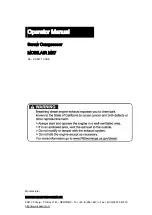
13-9-663 Page 57
It is mandatory that any water-cooled unit be installed in a shelter heated to
temperatures above freezing (32
°
F, 0
°
C).
Oil cooler malfunction may be traced by checking pressure at oil inlet and outlet. At normal operating air
service pressure (65 psig to 150 psig, 4.5 bar to 10.3 bar) with the unit warm, a pressure drop of 3 psi to
15 psi (.2 bar to 1 bar) can be expected between the oil inlet and the oil outlet.
Water pressure drop from water inlet to outlet will vary with the inlet pressure and amount of water
flowing. A normal pressure drop may range from 5 psi to 10 psi (.3 bar to .7 bar). Any change in the
pressure drop from that normally held may indicate tube leakage or fouling and should be investigated.
In many instances, the cooling water supply for the heat exchanger will contain impurities in solution
and/or suspension. These substances can cause scale formation, corrosion and plugging of any water-
cooled heat exchanger equipment. Disregarding the possibility that one or more of these conditions exist
may result in increased maintenance and operation expense, reduced equipment life and emergency
shutdown. It is strongly recommended that a reputable, local water treatment concern be engaged to
establish the corrosion, scale forming and fouling tendency of the cooling water and take steps necessary
to remedy the situation if a problem does exist. The need for water treatment may involve only filtration
(screening) to remove debris, sand and/or salt in the cooling water supply. However, chemical treatment
methods may be necessary in certain instances to inhibit corrosion and/or remove dissolved solids, to
alter the water’s tendency to form scale deposits, or prevent the growth of microorganisms. The normal
maintenance program for the unit should also include periodic cleaning of the tubes (water side) of the
heat exchanger to remove deposits which enhance fouling and corrosion.
Hex head zinc anodes are used in the return bonnet (opposite end to the water pipe connections) of heat
exchangers to provide internal water system corrosion protection. These anodes should be inspected
periodically and replaced when the zinc has been reduced to about 1/2 inch (13mm) in length.
Figure 5-10 – WATER CONTROL VALVE
















































